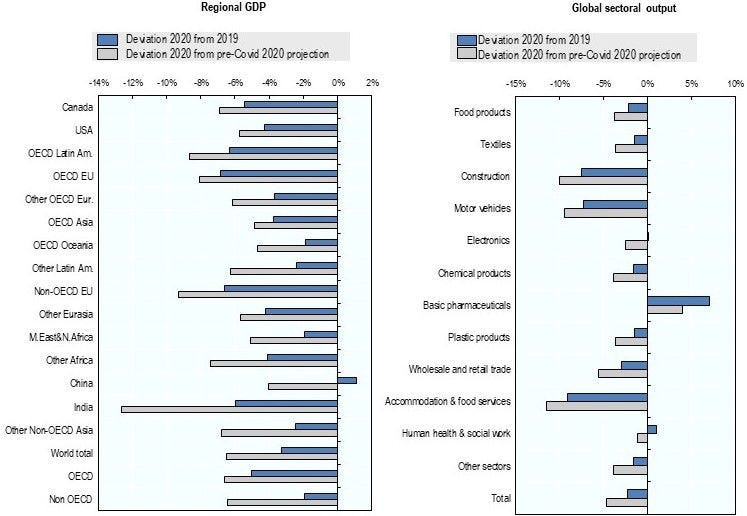The implications of the pandemic and lockdown measures are determined by comparing a counterfactual pre-Covid baseline scenario, i.e. the pre-Covid projection, with a scenario where the Covid-related shocks are included. The impacts of the COVID-19 pandemic and government response measures are based on the following modelling assumptions; see (Dellink et al., 2021[1]) for more details:
Increases in regional unemployment levels in 2020 are based on the OECD Economic Outlook 108 (OECD, 2020[2]), the updates on GDP forecasts in the Interim Outlook (OECD, 2021[3]) and the IMF Economic Outlook for the countries that are not covered by the OECD forecasts (IMF, 2020[4]). For the few countries missing in both databases, ad-hoc assumptions are made based on effects in similar countries.
Sectoral demand shocks are implemented for 2020 following Arriola and Van Tongeren (2021 forthcoming[5]). For energy sectors, the shocks are based on (IEA, 2020[6]). No demand shocks are included for the plastics producing sectors.
Short-term government stimulus packages as provided in 2020 are implemented as a reduction in capital and labour taxes for firms, and as a reduction in income taxes for households. These are based on Arriola et al. (2021 forthcoming[5]).
Trade shocks are implemented as an increase in the costs of international trade (“iceberg costs”), with a differentiation between services sectors and agriculture and manufacturing. This mimics the trade shocks in Arriola et al. (2021 forthcoming[5]).
Reductions in regional labour productivity reflect productivity losses during lockdown and is included crudely as a uniform decline in productivity in all sectors and regions, based on Arriola et al. (2021 forthcoming[5]).
Finally, regional total factor productivity shocks reflecting the combined effects of all elements not captured explicitly above are added based on the macroeconomic decline in GDP OECD (2020[2]). This approach ensures that the immediate effects of the pandemic on the macro economy are scaled to reach the GDP growth rates for 2020 as forecast by OECD (2020[2]) and by the IMF for the countries that are not covered by the OECD forecasts (IMF, 2020[4]).

